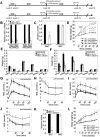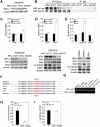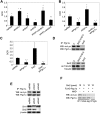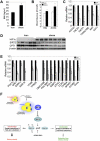Dietary obesity-associated Hif1α activation in adipocytes restricts fatty acid oxidation and energy expenditure via suppression of the Sirt2-NAD+ system
- PMID: 22302938
- PMCID: PMC3278893
- DOI: 10.1101/gad.180406.111
Dietary obesity-associated Hif1α activation in adipocytes restricts fatty acid oxidation and energy expenditure via suppression of the Sirt2-NAD+ system
Abstract
Dietary obesity is a major factor in the development of type 2 diabetes and is associated with intra-adipose tissue hypoxia and activation of hypoxia-inducible factor 1α (HIF1α). Here we report that, in mice, Hif1α activation in visceral white adipocytes is critical to maintain dietary obesity and associated pathologies, including glucose intolerance, insulin resistance, and cardiomyopathy. This function of Hif1α is linked to its capacity to suppress β-oxidation, in part, through transcriptional repression of sirtuin 2 (Sirt2) NAD(+)-dependent deacetylase. Reduced Sirt2 function directly translates into diminished deacetylation of PPARγ coactivator 1α (Pgc1α) and expression of β-oxidation and mitochondrial genes. Importantly, visceral adipose tissue from human obese subjects is characterized by high levels of HIF1α and low levels of SIRT2. Thus, by negatively regulating the Sirt2-Pgc1α regulatory axis, Hif1α negates adipocyte-intrinsic pathways of fatty acid catabolism, thereby creating a metabolic state supporting the development of obesity.
Figures






Similar articles
-
The diabetes medication canagliflozin promotes mitochondrial remodelling of adipocyte via the AMPK-Sirt1-Pgc-1α signalling pathway.Adipocyte. 2020 Dec;9(1):484-494. doi: 10.1080/21623945.2020.1807850. Adipocyte. 2020. PMID: 32835596 Free PMC article.
-
Metabolic remodeling in adipocytes promotes ciliary neurotrophic factor-mediated fat loss in obesity.Endocrinology. 2008 May;149(5):2546-56. doi: 10.1210/en.2007-1447. Epub 2008 Feb 14. Endocrinology. 2008. PMID: 18276754
-
Adipose tissue-specific inhibition of hypoxia-inducible factor 1{alpha} induces obesity and glucose intolerance by impeding energy expenditure in mice.J Biol Chem. 2010 Oct 22;285(43):32869-32877. doi: 10.1074/jbc.M110.135509. Epub 2010 Aug 16. J Biol Chem. 2010. PMID: 20716529 Free PMC article.
-
Age-dependent obesity and mitochondrial dysfunction.Adipocyte. 2017 Apr 3;6(2):161-166. doi: 10.1080/21623945.2017.1297346. Epub 2017 Mar 15. Adipocyte. 2017. PMID: 28425849 Free PMC article. Review.
-
Regulation of energy metabolism by long-chain fatty acids.Prog Lipid Res. 2014 Jan;53:124-44. doi: 10.1016/j.plipres.2013.12.001. Epub 2013 Dec 18. Prog Lipid Res. 2014. PMID: 24362249 Review.
Cited by
-
Ascent to altitude as a weight loss method: the good and bad of hypoxia inducible factor activation.Obesity (Silver Spring). 2014 Feb;22(2):311-7. doi: 10.1002/oby.20499. Epub 2013 Oct 15. Obesity (Silver Spring). 2014. PMID: 23625659 Free PMC article. Review.
-
Oxidative stress resulting from the removal of endogenous catalase induces obesity by promoting hyperplasia and hypertrophy of white adipocytes.Redox Biol. 2020 Oct;37:101749. doi: 10.1016/j.redox.2020.101749. Epub 2020 Oct 10. Redox Biol. 2020. PMID: 33080438 Free PMC article.
-
Sirtuins and Insulin Resistance.Front Endocrinol (Lausanne). 2018 Dec 6;9:748. doi: 10.3389/fendo.2018.00748. eCollection 2018. Front Endocrinol (Lausanne). 2018. PMID: 30574122 Free PMC article. Review.
-
Declining NAD(+) induces a pseudohypoxic state disrupting nuclear-mitochondrial communication during aging.Cell. 2013 Dec 19;155(7):1624-38. doi: 10.1016/j.cell.2013.11.037. Cell. 2013. PMID: 24360282 Free PMC article.
-
PPARα and Sirt1 mediate erythropoietin action in increasing metabolic activity and browning of white adipocytes to protect against obesity and metabolic disorders.Diabetes. 2013 Dec;62(12):4122-31. doi: 10.2337/db13-0518. Epub 2013 Aug 29. Diabetes. 2013. PMID: 23990359 Free PMC article.
References
-
- Buettner R, Parhofer KG, Woenckhaus M, Wrede CE, Kunz-Schughart LA, Scholmerich J, Bollheimer LC 2006. Defining high-fat-diet rat models: Metabolic and molecular effects of different fat types. J Mol Endocrinol 36: 485–501 - PubMed
-
- Cinti S 2009. Transdifferentiation properties of adipocytes in the adipose organ. Am J Physiol 297: E977–E986 doi: 10.1152/ajpendo.00183.2009 - PubMed
Publication types
MeSH terms
Substances
LinkOut - more resources
Full Text Sources
Other Literature Sources
Medical
Molecular Biology Databases
